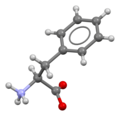Phenylalanine
 Skeletal formulaofL-phenylalanine
| |||
 L-Phenylalanine at physiological pH
| |||
| |||
| Names | |||
|---|---|---|---|
| Pronunciation | US:/ˌfɛnəlˈæləniːn/;UK:/ˌfiːnaɪl-/ | ||
| IUPAC name
Phenylalanine
| |||
| Systematic IUPAC name
(S)-2-Amino-3-phenylpropanoic acid | |||
| Identifiers | |||
3D model (JSmol)
|
|||
| ChEBI | |||
| ChEMBL | |||
| ChemSpider | |||
| DrugBank |
| ||
| ECHA InfoCard | 100.000.517 | ||
| |||
| KEGG |
| ||
PubChemCID
|
|||
| UNII |
| ||
CompTox Dashboard(EPA)
|
|||
| |||
| |||
| Properties | |||
| C9H11NO2 | |||
| Molar mass | 165.192g·mol−1 | ||
| 9.97 g/L at 0 °C 14.11 g/L at 25 °C | |||
| Acidity(pKa) | 1.83 (carboxyl), 9.13 (amino)[2] | ||
| Hazards | |||
| NFPA 704(fire diamond) | |||
| Supplementary data page | |||
| Phenylalanine (data page) | |||
Except where otherwise noted, data are given for materials in theirstandard state(at 25 °C [77 °F], 100 kPa).
| |||
Phenylalanine(symbolPheorF)[3]is an essential α-amino acidwith theformulaC
9H
11NO
2.It can be viewed as abenzylgroupsubstitutedfor themethyl groupofalanine,or aphenylgroup in place of a terminal hydrogen of alanine. Thisessential amino acidis classified as neutral, andnonpolarbecause of the inert andhydrophobicnature of thebenzylside chain. TheL-isomeris used to biochemically formproteinscoded for byDNA.Phenylalanine is a precursor fortyrosine,themonoamine neurotransmittersdopamine,norepinephrine(noradrenaline), andepinephrine(adrenaline), and thebiological pigmentmelanin.It isencodedby themessenger RNAcodonsUUU and UUC.
Phenylalanine is found naturally in the milk ofmammals.It is used in the manufacture of food and drink products and sold as a nutritional supplement as it is a direct precursor to theneuromodulatorphenethylamine.As an essential amino acid, phenylalanine is not synthesizedde novoin humans and other animals, who must ingest phenylalanine or phenylalanine-containing proteins.
The one-letter symbol F was assigned to phenylalanine for its phonetic similarity.[4]
History
[edit]The first description of phenylalanine was made in 1879, whenSchulzeand Barbieri identified a compound with theempirical formula,C9H11NO2,inyellow lupine(Lupinus luteus) seedlings. In 1882,Erlenmeyerand Lipp first synthesized phenylalanine fromphenylacetaldehyde,hydrogen cyanide,andammonia.[5][6]
The geneticcodonfor phenylalanine was first discovered byJ. Heinrich MatthaeiandMarshall W. Nirenbergin 1961. They showed that by usingmRNAto insert multipleuracilrepeats into thegenomeof thebacteriumE. coli,they could cause the bacterium to produce apolypeptideconsisting solely of repeated phenylalanine amino acids. This discovery helped to establish the nature of thecodingrelationship that links information stored ingenomicnucleic acid withprotein expressionin the living cell.
Dietary sources
[edit]Good sources of phenylalanine are eggs, chicken, liver, beef, milk, and soybeans.[7]Another common source of phenylalanine is anything sweetened with the artificial sweeteneraspartame,such asdiet drinks,diet foodsand medication; the metabolism of aspartame produces phenylalanine as one of the compound'smetabolites.[8]
Dietary recommendations
[edit]The Food and Nutrition Board (FNB) of the U.S. Institute of Medicine set Recommended Dietary Allowances (RDAs) foressential amino acidsin 2002. For phenylalanine plus tyrosine, for adults 19 years and older, 33 mg/kg body weight/day.[9]In 2005 the DRI is set to 27 mg/kg per day (with no tyrosine), theFAO/WHO/UNUrecommendation of 2007 is 25 mg/kg per day (with no tyrosine).[10]
Other biological roles
[edit]L-Phenylalanine is biologically converted intoL-tyrosine,another one of the DNA-encoded amino acids.L-tyrosine in turn is converted intoL-DOPA,which is further converted intodopamine,norepinephrine(noradrenaline), andepinephrine(adrenaline). The latter three are known as thecatecholamines.
Phenylalanine uses the same active transport channel astryptophanto cross theblood–brain barrier.In excessive quantities, supplementation can interfere with the production ofserotoninand otheraromatic amino acids[11]as well asnitric oxidedue to the overuse (eventually, limited availability) of the associated cofactors,ironortetrahydrobiopterin.[citation needed]The corresponding enzymes for those compounds are thearomatic amino acid hydroxylasefamily andnitric oxide synthase.
In plants
[edit]Phenylalanine is the starting compound used in thesynthesisofflavonoids.Lignanis derived from phenylalanine and fromtyrosine.Phenylalanine is converted tocinnamic acidby the enzymephenylalanine ammonia-lyase.[15]
Biosynthesis
[edit]Phenylalanine is biosynthesized via theshikimate pathway.
Phenylketonuria
[edit]The genetic disorderphenylketonuria(PKU) is the inability to metabolize phenylalanine because of a lack of the enzymephenylalanine hydroxylase.Individuals with this disorder are known as "phenylketonurics" and must regulate their intake of phenylalanine. Phenylketonurics often use blood tests to monitor the amount of phenylalanine in their blood. Lab results may report phenylalanine levels using either mg/dL and μmol/L. One mg/dL of phenylalanine is approximately equivalent to 60 μmol/L.
A (rare) "variant form" of phenylketonuria calledhyperphenylalaninemiais caused by the inability to synthesize acofactorcalledtetrahydrobiopterin,which can be supplemented. Pregnant women with hyperphenylalaninemia may show similar symptoms of the disorder (high levels of phenylalanine in blood), but these indicators will usually disappear at the end of gestation. Pregnant women with PKU must control their blood phenylalanine levels even if the fetus is heterozygous for the defective gene because the fetus could be adversely affected due to hepatic immaturity.[medical citation needed]
A non-food source of phenylalanine is the artificial sweeteneraspartame.This compound is metabolized by the body into several chemical byproducts including phenylalanine. The breakdown problems phenylketonurics have with the buildup of phenylalanine in the body also occurs with the ingestion of aspartame, although to a lesser degree. Accordingly, all products in Australia, the U.S. and Canada that contain aspartame must be labeled: "Phenylketonurics: Contains phenylalanine." In the UK, foods containing aspartame must carry ingredient panels that refer to the presence of "aspartame or E951"[16]and they must be labeled with a warning "Contains a source of phenylalanine." In Brazil, the label "Contém Fenilalanina" (Portuguese for "Contains Phenylalanine" ) is also mandatory in products which contain it. These warnings are placed to help individuals avoid such foods.
D-,L- andDL-phenylalanine
[edit]ThestereoisomerD-phenylalanine(DPA) can be produced by conventionalorganic synthesis,either as a singleenantiomeror as a component of theracemicmixture. It does not participate inprotein biosynthesisalthough it is found in proteins in small amounts - particularly aged proteins and food proteins that have beenprocessed.The biological functions ofD-amino acids remain unclear, althoughD-phenylalanine haspharmacological activityatniacin receptor 2.[17]
DL-Phenylalanine (DLPA) is marketed as a nutritional supplement for its purportedanalgesicandantidepressantactivities, which have been supported by clinical trials.[18][19][20]DL-Phenylalanine is a mixture ofD-phenylalanine andL-phenylalanine. The reputed analgesic activity ofDL-phenylalanine may be explained by the possible blockage byD-phenylalanine ofenkephalindegradationby theenzymecarboxypeptidase A.[21][22]Enkephalins act as agonists of themuanddelta opioid receptors,and agonists of these receptors are known to produce antidepressant effects.[23]The mechanism ofDL-phenylalanine's supposed antidepressant activity may also be accounted for in part by theprecursorrole ofL-phenylalanine in the synthesis of theneurotransmittersnorepinephrineanddopamine,though clinical trials have not found an antidepressant effect fromL-phenylalanine alone.[18]Elevated brain levels of norepinephrine and dopamine are thought to have an antidepressant effect.D-Phenylalanine is absorbed from thesmall intestineand transported to the liver via theportal circulation.A small amount ofD-phenylalanine appears to be converted toL-phenylalanine.D-Phenylalanine is distributed to the various tissues of the body via thesystemic circulation.It appears to cross theblood–brain barrierless efficiently thanL-phenylalanine, and so a small amount of an ingested dose ofD-phenylalanine is excreted in theurinewithout penetrating the central nervous system.[24]
L-Phenylalanine is an antagonist atα2δ Ca2+calcium channelswith a Kiof 980 nM.[25]
In the brain,L-phenylalanine is acompetitive antagonistat theglycinebinding site ofNMDA receptor[26]and at theglutamatebinding site ofAMPA receptor.[27]At theglycinebinding site ofNMDA receptorL-phenylalanine has an apparent equilibrium dissociation constant (KB) of 573 μM estimated bySchild regression[28]which is considerably lower than brainL-phenylalanine concentration observed in untreated humanphenylketonuria.[29] L-Phenylalanine also inhibitsneurotransmitterrelease atglutamatergicsynapsesinhippocampusandcortexwithIC50of 980 μM, a brain concentration seen in classicalphenylketonuria,whereasD-phenylalanine has a significantly smaller effect.[27]
Commercial synthesis
[edit]L-Phenylalanine is produced for medical, feed, and nutritional applications, such asaspartame,in large quantities by utilizing the bacteriumEscherichia coli,which naturally producesaromatic amino acidslike phenylalanine. The quantity ofL-phenylalanine produced commercially has been increased bygenetically engineeringE. coli,such as by altering the regulatorypromotersor amplifying the number ofgenescontrolling enzymes responsible for the synthesis of the amino acid.[30]
Derivatives
[edit]Boronophenylalanine(BPA) is a dihydroxyboryl derivative of phenylalanine, used inneutron capture therapy.
4-Azido-L-phenylalanineis a protein-incorporated unnatural amino acid used as a tool forbioconjugationin the field ofchemical biology.
References
[edit]- ^abIhlefeldt FS, Pettersen FB, von Bonin A, Zawadzka M, Görbitz PC (2014). "The Polymorphs of L-Phenylalanine".Angew. Chem. Int. Ed.53(49): 13600–13604.doi:10.1002/anie.201406886.PMID25336255.
- ^Dawson RM, et al. (1959).Data for Biochemical Research.Oxford: Clarendon Press.
- ^"Nomenclature and Symbolism for Amino Acids and Peptides".IUPAC-IUB Joint Commission on Biochemical Nomenclature. 1983. Archived fromthe originalon 9 October 2008.Retrieved5 March2018.
- ^"IUPAC-IUB Commission on Biochemical Nomenclature A One-Letter Notation for Amino Acid Sequences".Journal of Biological Chemistry.243(13): 3557–3559. 10 July 1968.doi:10.1016/S0021-9258(19)34176-6.
- ^Thorpe TE(1913).A Dictionary of Applied Chemistry.Longmans, Green, and Co. pp.191–193.Retrieved2012-06-04.
- ^Plimmer RH (1912) [1908]. Plimmer RH, Hopkins FG (eds.).The Chemical Composition of the Proteins.Monographs on Biochemistry. Vol. Part I. Analysis (2nd ed.). London: Longmans, Green and Co. pp. 93–97.Retrieved2012-06-04.
- ^Ross HM, Roth J (1 April 1991).The Mood Control Diet: 21 Days to Conquering Depression and Fatigue.Simon & Schuster. p. 59.ISBN978-0-13-590449-7.
- ^Zeratsky K."Phenylalanine in diet soda: Is it harmful?".Mayo Clinic.Retrieved30 April2019.
- ^Institute of Medicine(2002)."Protein and Amino Acids".Dietary Reference Intakes for Energy, Carbohydrates, Fiber, Fat, Fatty Acids, Cholesterol, Protein, and Amino Acids.Washington, DC: The National Academies Press. pp. 589–768.doi:10.17226/10490.ISBN978-0-309-08525-0.
- ^Elango R, Ball RO, Pencharz PB (August 2012)."Recent advances in determining protein and amino acid requirements in humans".British Journal of Nutrition.108(S2): S22–S30.doi:10.1017/S0007114512002504.ISSN0007-1145.PMID23107531.
- ^Eriksson JG, Guzzardi MA, Iozzo P, Kajantie E, Kautiainen H, Salonen MK (2017-01-01)."Higher serum phenylalanine concentration is associated with more rapid telomere shortening in men".The American Journal of Clinical Nutrition.105(1): 144–150.doi:10.3945/ajcn.116.130468.ISSN0002-9165.PMID27881392.
- ^Broadley KJ (March 2010). "The vascular effects of trace amines and amphetamines".Pharmacology & Therapeutics.125(3): 363–375.doi:10.1016/j.pharmthera.2009.11.005.PMID19948186.
- ^Lindemann L, Hoener MC (May 2005). "A renaissance in trace amines inspired by a novel GPCR family".Trends in Pharmacological Sciences.26(5): 274–281.doi:10.1016/j.tips.2005.03.007.PMID15860375.
- ^Wang X, Li J, Dong G, Yue J (February 2014). "The endogenous substrates of brain CYP2D".European Journal of Pharmacology.724:211–218.doi:10.1016/j.ejphar.2013.12.025.PMID24374199.
- ^Nelson DL, Cox MM (2000).Lehninger, Principles of Biochemistry(3rd ed.). New York: Worth Publishing.ISBN1-57259-153-6.
- ^"Aspartame".UK: Food Standards Agency. Archived fromthe originalon 2012-02-21.Retrieved2007-06-19.
- ^"D-Phenylalanine: Biological activity".The IUPHAR/BPS Guide to PHARMACOLOGY.Retrieved27 December2018.
- ^abWood DR, Reimherr FW, Wender PH (1985). "Treatment of attention deficit disorder with DL-phenylalanine".Psychiatry Research.16(1). Elsevier BV: 21–26.doi:10.1016/0165-1781(85)90024-1.ISSN0165-1781.PMID3903813.S2CID3077060.
- ^Beckmann H, Strauss MA, Ludolph E (1977). "DL-Phenylalanine in depressed patients: An open study".Journal of Neural Transmission.41(2–3). Springer Science and Business Media LLC: 123–134.doi:10.1007/bf01670277.ISSN0300-9564.PMID335027.S2CID5849451.
- ^Beckmann H, Athen D, Olteanu M, Zimmer R (1979). "DL-Phenylalanine versus imipramine: A double-blind controlled study".Archiv für Psychiatrie und Nervenkrankheiten.227(1). Springer Science and Business Media LLC: 49–58.doi:10.1007/bf00585677.ISSN0003-9373.PMID387000.S2CID23531579.
- ^"D-Phenylalanine: Clinical data".The IUPHAR/BPS Guide to PHARMACOLOGY.Retrieved27 December2018.
- ^Christianson DW,Mangani S, Shoham G, Lipscomb WN (August 1989)."Binding of D-phenylalanine and D-tyrosine to carboxypeptidase A"(PDF).The Journal of Biological Chemistry.264(22): 12849–12853.doi:10.1016/S0021-9258(18)51564-7.PMID2568989.
- ^Jelen LA, Stone JM, Young AH, Mehta MA (2022)."The opioid system in depression".Neuroscience & Biobehavioral Reviews.140.Elsevier BV: 104800.doi:10.1016/j.neubiorev.2022.104800.ISSN0149-7634.PMC10166717.PMID35914624.S2CID251163234.
- ^Lehmann WD, Theobald N, Fischer R, Heinrich HC (1983-03-14). "Stereospecificity of phenylalanine plasma kinetics and hydroxylation in man following oral application of a stable isotope-labelled pseudo-racemic mixture of L- and D-phenylalanine".Clinica Chimica Acta; International Journal of Clinical Chemistry.128(2–3): 181–198.doi:10.1016/0009-8981(83)90319-4.ISSN0009-8981.PMID6851137.
- ^Mortell KH, Anderson DJ, Lynch JJ, Nelson SL, Sarris K, McDonald H, et al. (March 2006). "Structure-activity relationships of Alpha -amino acid ligands for the Alpha 2delta subunit of voltage-gated calcium channels".Bioorganic & Medicinal Chemistry Letters.16(5): 1138–4111.doi:10.1016/j.bmcl.2005.11.108.PMID16380257.
- ^Glushakov AV, Dennis DM, Morey TE, Sumners C, Cucchiara RF, Seubert CN, et al. (2002)."Specific inhibition ofN-methyl-D-aspartate receptor function in rat hippocampal neurons by L-phenylalanine at concentrations observed during phenylketonuria ".Molecular Psychiatry.7(4): 359–367.doi:10.1038/sj.mp.4000976.PMID11986979.
- ^abGlushakov AV, Dennis DM, Sumners C, Seubert CN, Martynyuk AE (April 2003). "L-Phenylalanine selectively depresses currents at glutamatergic excitatory synapses".Journal of Neuroscience Research.72(1): 116–124.doi:10.1002/jnr.10569.PMID12645085.S2CID42087834.
- ^Glushakov AV, Glushakova O, Varshney M, Bajpai LK, Sumners C, Laipis PJ, et al. (February 2005)."Long-term changes in glutamatergic synaptic transmission in phenylketonuria".Brain.128(Pt 2): 300–307.doi:10.1093/brain/awh354.PMID15634735.
- ^Möller HE, Weglage J, Bick U, Wiedermann D, Feldmann R, Ullrich K (December 2003). "Brain imaging and proton magnetic resonance spectroscopy in patients with phenylketonuria".Pediatrics.112(6 Pt 2): 1580–1583.doi:10.1542/peds.112.S4.1580.hdl:11858/00-001M-0000-0010-A24A-C.PMID14654669.S2CID2198040.
- ^Sprenger GA (2007). "Aromatic Amino Acids".Amino Acid Biosynthesis: Pathways, Regulation and Metabolic Engineering(1st ed.). Springer. pp. 106–113.ISBN978-3-540-48595-7.





